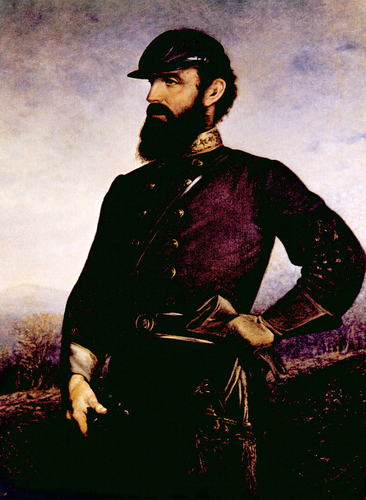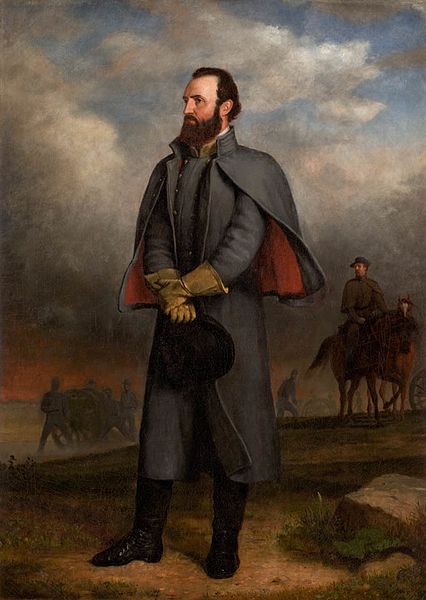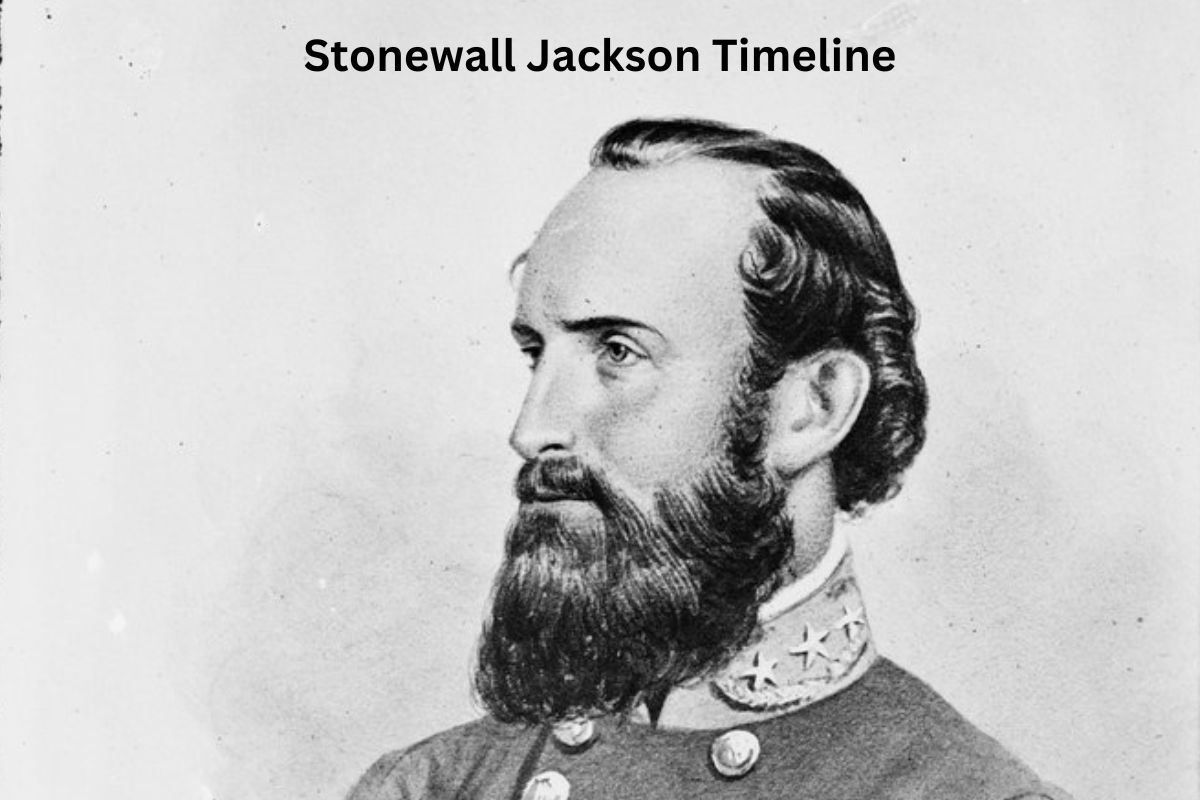Stonewall Jackson, born on January 21, 1824, in Clarksburg, Virginia, was a prominent Confederate general during the American Civil War.
He graduated from West Point in 1846, served in the Mexican-American War, and became a respected professor at the Virginia Military Institute (VMI) in 1851.
During the Civil War, Jackson earned the nickname “Stonewall” for his unwavering defense at the First Battle of Bull Run in 1861. His tactical brilliance and aggressive strategies contributed to Confederate victories.
Tragically, he was accidentally shot at the Battle of Chancellorsville in 1863, leading to his death on May 10, 1863. He is buried in Lexington, Virginia. Stonewall Jackson’s legacy is defined by his military skill and impact on the Civil War.
| Year | Event |
|---|---|
| 1824 | Stonewall Jackson is born in Clarksburg, Virginia (now West Virginia). |
| 1842 | Jackson enters the United States Military Academy at West Point, where he graduates in 1846. |
| 1846-1848 | Mexican-American War: Jackson serves as a second lieutenant in the U.S. Army during the war, earning a reputation for bravery. |
| 1851 | Jackson resigns from the U.S. Army and accepts a teaching position at the Virginia Military Institute (VMI) in Lexington, Virginia. |
| 1853 | He marries Elinor “Ellie” Junkin, but she dies of childbirth complications in 1854 along with their newborn son. |
| 1857 | Jackson marries Mary Anna Morrison. They have a daughter together. |
| 1861 | The American Civil War begins. Jackson becomes a Confederate officer and quickly rises through the ranks due to his military skill. |
| 1861-1862 | Jackson earns his famous nickname “Stonewall” during the First Battle of Bull Run (First Manassas) in July 1861, where he and his brigade held a strong defensive line and stood “like a stone wall.” He continues to have success in subsequent battles in the Shenandoah Valley. |
| 1862 | Jackson plays a significant role in the Peninsula Campaign, the Battle of Second Bull Run (Second Manassas), and the Battle of Antietam. |
| 1863 | Jackson’s most famous campaign occurs in the spring, known as Jackson’s Valley Campaign, where he outmaneuvers Union forces and wins a series of battles in the Shenandoah Valley. |
| May 2-3, 1863 | During the Battle of Chancellorsville, Jackson is accidentally shot by his own men. His left arm is amputated, and he dies of pneumonia on May 10, 1863, at Guinea Station, Virginia. |
| 1863 | Stonewall Jackson is buried in Lexington, Virginia. |
Timeline of Stonewall Jackson
1824: Stonewall Jackson is born in Clarksburg, Virginia (now West Virginia)
Stonewall Jackson, whose birth name was Thomas Jonathan Jackson, was born on January 21, 1824, in Clarksburg, Virginia.
At the time of his birth, this region was part of Virginia, but it is now located in the state of West Virginia. He was born into a modest family and grew up in the Appalachian region of the United States.
1842: Jackson enters the United States Military Academy at West Point, where he graduates in 1846
In 1842, at the age of 18, Thomas Jackson entered the United States Military Academy at West Point, New York. This prestigious military academy has trained many future military leaders throughout American history.
Jackson’s time at West Point was marked by his dedication to his studies and military training, which laid the foundation for his future career as a soldier.

1846-1848: Mexican-American War: Jackson serves as a second lieutenant in the U.S. Army during the war, earning a reputation for bravery
Thomas Jackson graduated from West Point in 1846 and was commissioned as a second lieutenant in the U.S. Army. Shortly after his graduation, he saw active service in the Mexican-American War, which lasted from 1846 to 1848.
During this conflict, Jackson demonstrated his bravery and leadership abilities on the battlefield. He participated in several engagements, gaining valuable combat experience that would later serve him well during the American Civil War.
1851: Jackson resigns from the U.S. Army and accepts a teaching position at the Virginia Military Institute (VMI) in Lexington, Virginia
In 1851, Thomas Jackson resigned from the U.S. Army. His decision to leave the military was influenced by personal and professional considerations.
He accepted a position as a professor of natural and experimental philosophy (a combination of physics and mathematics) at the Virginia Military Institute (VMI) in Lexington, Virginia. At VMI, Jackson was known for his strict and disciplined teaching methods.
He became a respected member of the faculty and continued to pursue his passion for military strategy and tactics.
1853: He marries Elinor “Ellie” Junkin, but she dies of childbirth complications in 1854 along with their newborn son
In 1853, Thomas Jackson married Elinor “Ellie” Junkin. Their marriage was relatively short-lived, as Elinor tragically died just a year later in 1854 due to childbirth complications. The infant son also did not survive. This loss was a profound personal tragedy for Jackson, and it left a lasting impact on his life.
1857: Jackson marries Mary Anna Morrison. They have a daughter together
In 1857, Thomas Jackson married Mary Anna Morrison, who would become his second wife. Mary Anna was a devoted partner to Jackson throughout their marriage and became an important source of emotional support for him during his military career. The couple had a daughter together, Julia Laura Jackson, who was born in 1862.

1861: The American Civil War begins. Jackson becomes a Confederate officer and quickly rises through the ranks due to his military skill
In 1861, with the outbreak of the American Civil War, Thomas Jackson became deeply involved in the conflict. He joined the Confederate forces and was commissioned as a colonel. His military experience and strategic prowess quickly gained recognition, and he was promoted to brigadier general in the Confederate Army.
1861-1862: Jackson earns his famous nickname “Stonewall” during the First Battle of Bull Run (First Manassas) in July 1861
During the First Battle of Bull Run, also known as the First Battle of Manassas, in July 1861, Jackson earned his famous nickname, “Stonewall.”
The moniker came from General Barnard Bee’s exclamation to his troops, urging them to rally around Jackson, saying, “There is Jackson standing like a stone wall!”
Also Read: Timeline of the Battle of Bull Run
This nickname stuck with Jackson throughout the war. In the months following First Bull Run, Jackson led his troops to success in several battles in the Shenandoah Valley, showcasing his tactical brilliance.
1862: Jackson plays a significant role in the Peninsula Campaign, the Battle of Second Bull Run (Second Manassas), and the Battle of Antietam
In 1862, Jackson played a pivotal role in the Peninsula Campaign, which was part of the larger Union effort to capture Richmond, the Confederate capital.
His tactics and maneuvers in the Shenandoah Valley and during the Peninsula Campaign earned him a reputation as one of the Confederacy’s most effective generals.
He also played a significant role in the Second Battle of Bull Run (Second Manassas) in August 1862, where Confederate forces, under Jackson’s leadership, secured a decisive victory against Union forces.
1863: Jackson’s most famous campaign occurs in the spring, known as Jackson’s Valley Campaign, where he outmaneuvers Union forces and wins a series of battles in the Shenandoah Valley
Later in 1862, Stonewall Jackson participated in the Battle of Antietam, which took place near Sharpsburg, Maryland, in September. The Battle of Antietam was one of the bloodiest battles of the Civil War and ended inconclusively.
Jackson’s leadership during the battle was crucial in holding the Confederate lines, although the battle itself had a high cost in terms of casualties on both sides.
May 2-3, 1863: During the Battle of Chancellorsville, Jackson is accidentally shot by his own men. His left arm is amputated, and he dies of pneumonia on May 10, 1863, at Guinea Station, Virginia
In May 1863, during the Battle of Chancellorsville, one of the most significant engagements of the American Civil War, tragedy struck Stonewall Jackson.
While conducting a reconnaissance mission on the night of May 2, Jackson and his staff were accidentally fired upon by Confederate troops who mistook them for Union soldiers in the darkness. Jackson was severely wounded, with multiple gunshot wounds, most notably to his left arm.
As a result of the injuries, Jackson’s left arm had to be amputated. His condition deteriorated due to complications from the surgery and pneumonia.
Despite the best efforts of his medical team and his wife, Mary Anna Jackson, who had rushed to be by his side, he succumbed to his injuries and passed away on May 10, 1863, at Guinea Station, Virginia.
1863: Stonewall Jackson is buried in Lexington, Virginia
After his death, Stonewall Jackson was buried with full military honors in the cemetery at the Stonewall Jackson Memorial Cemetery in Lexington, Virginia. His gravesite remains a place of reverence and is visited by Civil War enthusiasts and historians.
Jackson’s death was a significant loss for the Confederate cause. He was widely mourned in the South, and his legacy continued to be celebrated. His tactical brilliance, unwavering determination, and bold leadership left an indelible mark on the history of the American Civil War. His untimely death at the age of 39 deprived the Confederacy of one of its most effective and revered generals.
